|
Ito Sekisui V
Living National Treasure (LNT)
by Robert Yellin
for The Japan Times: June 21, 2003
Click here for list/photos of prior LNT winners
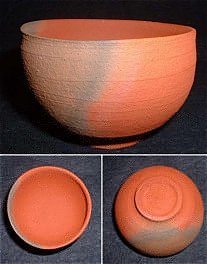
Mumyoi Guinomi by Ito Sekisui V
Ito Sekisui V (1941 - ) was recently (June 2003) designated a Living National Treasure by the Japanese government.
I've always admired Ito's work -- my Yakimono Sanka book, first published in 1995 by Kogei Shuppan, includes a photo of a small Ito sake cup. Ito's mumyoi work, with its brilliant red and black contrasts, is one of the hidden treasures of Japanese yakimono. And on top of that he arguably makes the best neriage marbled wares in the world that I've seen, certainly his is THE BEST in Japan. I was expecting a Bizen or Setoguro LNT this year, thus the Ito designation was actually a breath of fresh air for the yakimono world. The reason being it's the first for mumyoi and will certainly boost the image of the style for Ito and the other mumyoi-yaki potters. Also, Ito is not "related" to any major teachers, nor was his father a LNT. Ito earned it on his own just like the first wave of LNT potters.
Below is a very brief English excerpt from a pamphlet that is handed out at the Seksui kiln:
MUMYOI POTTERY SEKISUI KILN
"The fine ceramic wares created in the Sekisui family kiln are made form a special red potter's clay known as mumyoi. The clay is extracted form gold and silver mines located on Sado Island. The craftsmanship that goes into every piece of mumyoi pottery has been passed from father to son for over 150 years. The Sekisui kiln is located in the town of Aikawa on Sado Island. The kiln's history began when Tomisaburo Ito founded the pottery during the Tempo Era of the Edo Period, more precisely Tempo 2 (1831). Tomisaburo is known as the 'father of the Sekisui kiln' and the first muyoi potter."
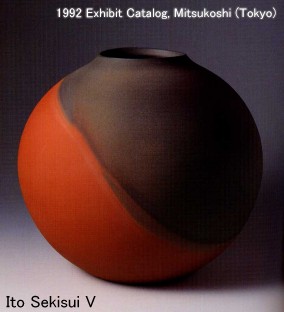
A little bit more about mumyoi and Ito. The current Sekisui was born Yoichi, "yo" being the kanji for kiln. He was the first in his family to get a formal education, graduating from the Kyoto Technical University with a degree in ceramics in 1966. In 1972 his work was accepted into the elite Japan Traditional Arts and Crafts exhibition and the following year he won the grand prix in the 2nd Japan Ceramic Art exhibition.
He took the name Sekisui V in 1977. Around that time he started experimenting with firing an anagama in a reduction mode to bring about the black and red contrasts that he is now so well known for. It has been compared to Yayoi period wares, which often display the same effects. He started creating his neriage around 1980.
The Ito family is not the only mumyoi potters on Sado. In fact, that is where another Living National Treasure hails from -- Miura Koheji, the LNT for celadon. His family dates back to Meiji 6 (1873). The first Miura was also named Koheiji and later took the name Jozan. There are twelve active kilns in Aikawa today, and between 20-30 in all of Sado.
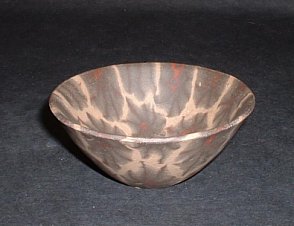
Nerikomi Sakazuki by Ito Sekisui V
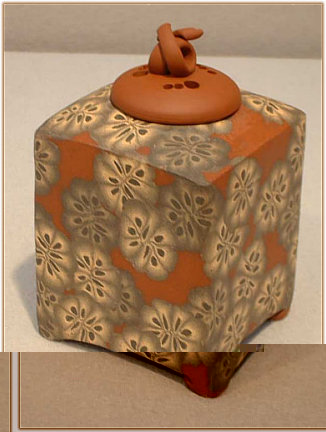
Neriage Koro by Ito Sekisui V
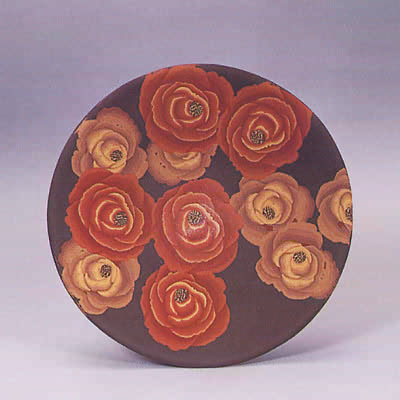
Neriage bowl by Ito Sekisui V
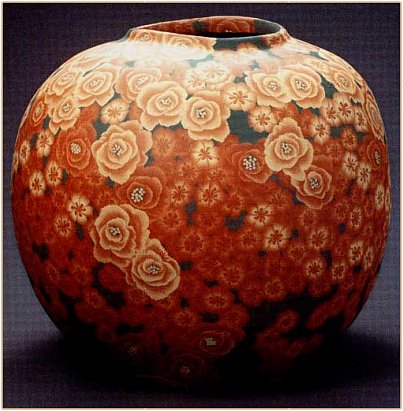
Neriage Jar by Ito Sekisui V
Photo courtesy DAIMARU MUSEUM
Below is a brief article about the recent LNT awards:
(courtesy The Japan Times, June 21, 2003):
Kabuki actor Onoe Kikugoro and nine others were selected Friday by a cultural panel to be named living national treasures, according to the Education, Culture, Sports, Science and Technology Ministry.
The Council for Cultural Affairs, headed by art critic Shuji Takashina, reported its recommendations to culture minister Atsuko Toyama. The honorees will have the title formally bestowed on them around July 10.
Kikugoro's late father, Onoe Baiko VII, was recognized as an intangible cultural treasure in 1968 for specializing in female roles on the kabuki stage. Kikugoro, a 60-year-old Tokyo resident whose real name is Hideyuki Terajima, and the others will bring the number of living national treasures to 115. The cumulative total, including people who have died and lost the status, will be 301. Kikugoro, who plays male characters, will be the 15th performer to be granted the status in the wake of a parent, and the fourth kabuki actor to do so, according to the Agency for Cultural Affairs.
Among the other honorees is Mitsufumi Shimabukuro, 82, a drum master in traditional Okinawa "kumiodori" musicals, which are recognized as an intangible cultural heritage. He lives in Naha.
Also named was potter Ito Sekisui V, 61, whose real name is Yoichi Ito. He produces "mumyoiyaki" ware, made with red ocher clay known as mumyoi from Sado Island. He lives in Aikawa on the Niigata Prefecture island.
Kiyomoto Seijudayu, a "joruri" puppeteer whose real name is Yoshitada Sagawa, and Kiyomoto Eizo, a shamisen player born Yasukazu Koyanagi, both 67 and living in Tokyo, will also be honored.
The council selected kabuki hairdresser Toshikazu Kamoji, 65, three other people and an Okinawa traditional arts group as the first technical experts in identifying and preserving cultural assets.
The Japan Times: June 21, 2003
(C) All rights reserved
.
|